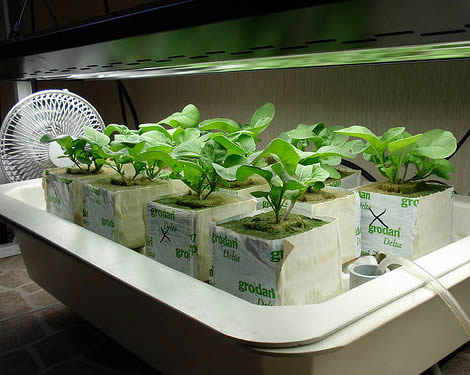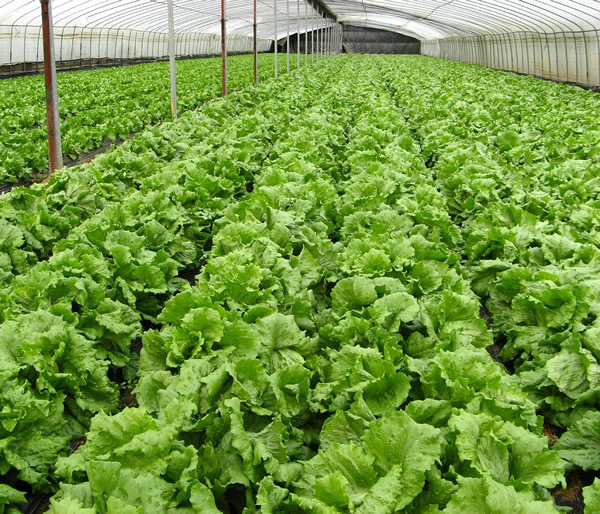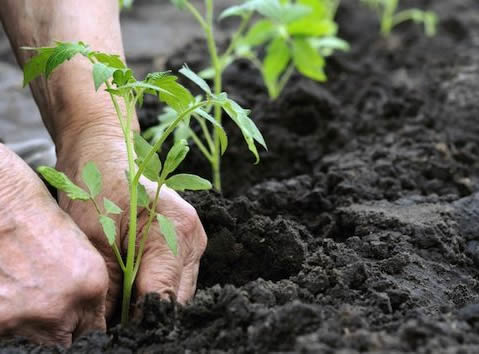 |
| Organic Gardening and Farming |
Organic growing strives to produce healthy soils and plants through practices that replenish and maintain soil fertility. Organic farmers avoid the use of synthetic and often toxic fertilizers and pesticides.
At the beginning of agricultural history, farmers believed that plants “ate the soil” in order to grow. During the nineteenth century, German chemist Justus von Liebig discovered that plants extracted nitrogen, phosphorus, and potash from the soil.
His findings dramatically changed agriculture as farmers found they could grow crops in any type of soil, even sand and water solutions, if the right chemicals were added.
By the late twentieth century, diversified family farms in industrialized nations had given way to huge, specialized operations. Crop yields were raised with the use of chemicals, but farms and their soil and water were not being used efficiently. Over time, the organic quality of the soil was lost, even though the agricultural chemicals remained in the soil.
  |
Chemicals were found to leach into the water supply. In 1988 the U.S. Environmental Protection Agency (EPA) found that groundwater in thirty-two states was contaminated with seventy-four different agricultural chemicals. Leaching causes once-friable and fertile soils to become nonproductive.
Further, the use of chemical insecticides was having toxic effects on both the foods grown and the farm workers encountering them. About forty-five thousand accidental pesticide poisonings occur in the United States each year; in 1987 the EPA ranked pesticides as the third leading environmental cancer risk.
A National Academy of Science study estimated that twenty thousand people each year get cancer because of pesticides alone. Growing public awareness of the effects of the traditional agricultural reliance on synthetic chemicals is reflected in a growing demand for organically produced foods.
Tenets of Organic Farming
 |
| Tenets of Organic Farming |
Organic farming represents the use of diversified farming practices that emphasize working with nature to create an ecologically sound and sustainable system of agriculture. Certified organic farmers are bound by practices that are free of synthetic chemicals and genetic engineering.
Lands must be chemical-free for at least three years before products grown on them can be certified as organic. The organic certification further requires that both plants and livestock be raised without the use of chemicals, antibiotics, hormones, or synthetic feed additives.
Certified organic farmers must comply with both organic regulations in their state and the 1990 Organic Foods Production Act (OFPA). In the late 1990’s the U.S. Department of Agriculture (USDA), through the National Organic Standards Board (NOSB), began working to develop standards and regulations that would ensure consistent national standards for organic products.
There are six areas of standards that the NOSB is examining: crops; livestock and livestock products; processing, packaging and labeling; accreditation; international issues; and materials. There is interest in developing global standards for the importation and exportation of organic products.
Soil Fertility
Like all farmers, organic farmers must ensure soil fertility and control unwanted plants and pests. Organic farmers build organic materials in the soil by the addition of green manure, compost, or animal manure. Green manure is the term used for crops that are grown to introduce organic matter and nutrients into the soil.
Such crops are raised expressly for the purpose of being plowed under rather than sold to the consumer. Green manure crops protect soil against erosion, cycle nutrients from lower levels of the soil into the upper layers, suppress weeds, and keep much-needed nutrients in the soil.
Legumes are an excellent green manure crop because they are efficient at extracting nitrogen from the air and transferring it into the soil, leaving a supply of nitrogen for the next crop.
 |
| Soil fertility |
The legumes have nitrogen nodules on their roots; when the legumes are tilled under and decompose, they add more nitrogen to the soil. As plants decay, they also make insoluble plant nutrients such as carbon dioxide and organic acids available in the soil.
Much of the organic material derived from green manure comes in the form of decaying roots. Alfalfa, one type of legume, sends its roots several feet down into the soil.
When alfalfa plants are turned, the entire root system decomposes into organic material. Thus they help improve water retention and soil quality at the same time. Some examples of legumes used for green manure are sweet clover, ladino clover, and trefoil. Grasses used for green manure include rye, red top, and timothy grass.
Greater fertility can be achieved if green manure is grazed by animals and animal manure is deposited on the soil. When grass is grazed, a proportion of the roots die and rot to form humus. This humus is the stable organic material that acts as a catalyst for allowing plants to find nutrients.
Animal manure is also used as an organic fertilizer. Rich in nitrogen, the best animal manures come from animals with high-protein diets. For example, beef cattle being fattened for market consume a higher level of protein than dairy cattle that are producing milk for market.
The application of manure to fields improves the structure of the soil, raises organic nitrogen content, and stimulates the growth of soil bacteria and fungi necessary for healthy soils.
Compost is particularly useful to the small-scale farmer or gardener who does not raise livestock or have the acreage to grow a green manure crop to plow under. Composting is a natural soil-building process that began with the first plants that existed on earth. It continues to be employed as a natural process today.
As leaves and dead plants, animals, and insects decompose into the soil, they form a rich, organic layer. Compost can be made by farmers and gardeners by using alternating layers of carbohydrate-rich plant cuttings and leaves, animal manure, and topsoil and allowing it to decay and form a rich, organic matter to be added to the soil.
Crop Rotation
 |
| Crop rotation |
Planting the same crop year after year on the same piece of ground results in depleted soil. Crops such as corn, tobacco, and cotton remove nutrients, especially nitrogen, from the soil. In order to keep the soil fertile, a legume should be planted the year after a cash crop in order to add nitrogen and achieve a balanced nutrient level.
Planting a winter cover crop such as rye grass will help protect land from erosion and will, when plowed under in the spring, provide a nutrient-rich soil for the growth of a cash crop. Crop rotation also improves the physical condition of the soil because different crops vary in root depth and respond to either deep or shallow soil preparation.
Organic Insect and Weed Control
Monoculture puts a large amount of the same crop in proximity to pests that are destructive to that particular crop. Insect offspring can multiply out of proportion when the same crops are grown in the same field year after year.
   |
Because insects are drawn to the same home area, they are less able to proliferate if the crop is changed to one they cannot eat. For this reason, organic farmers rely on crop rotation as one aspect of insect control. Rotating crops can also help control weeds.
Some crops and cultivation methods inadvertently allow certain weeds to thrive. Crop rotation can incorporate a successor crop that eradicates those weeds. Some crops, such as potatoes and winter squash, work as “cleaning crops” because of the different styles of cultivation that are used on them.
Organic farmers and gardeners believe that plants within a balanced ecosystem are resistant to disease and pest infestation. Therefore, the whole premise of organic farming is working with nature to help grow healthy, unstressed plants.
Rather than using chemicals, which often create resistant generations of pests and thus the need for newer and stronger chemicals, organic farmers have found natural ways to diminish pest problems.
Organic farmers strive to maintain and replenish soil fertility to produce healthy plants resistant to insects. They also try to select plant species that are naturally resistant to insects, weeds, and disease.
Crop rotation, as already discussed, is one method of keeping infestation down. Rows of hedges, trees, or even plants that are not desirable to insects planted in and around the crop field can act as barriers to pests. They can also provide habitat for pests’ natural enemies, including birds, beneficial insects, and snakes.
Beneficial insects can be ordered through the mail to help alleviate insect pests. The ladybug and the praying mantis are two insects that can help rid farms or gardens of aphids, mites, mealy bugs, and grasshoppers. Just one ladybug can consume fifty or more aphids per day.
Because most people order ten thousand to twenty thousand ladybugs for their garden, and one ladybug can lay up to one thousand fertile eggs, the overall cost of biopesticides is much less than that of buying insecticides. Trichogramma, also available by mail order, is a small wasp that will destroy moth eggs, squash borers, cankerworms, cabbage loopers, and corn earworms.
Organic farmers and gardeners also rely on what is called an insecticide crop. Garlic planted near lettuce and peas will deter aphids. Geraniums or marigolds grown close to grapes, cantaloupes, corn, and cucumbers will deter Japanese and cucumber beetles. Herbs such as rosemary, sage, and thyme planted by cabbages will deter white butterfly pests.
Potatoes will repel Mexican bean beetles if planted near beans, and tomatoes planted near asparagus will ward off asparagus beetles. Natural insecticides such as red pepper juice can be used for ant control, while a combination of garlic oil and lemon may be used against fleas, mosquito larvae, houseflies, and other insects.
Organic farming relies on the physical control of weeds, especially through the use of cutting (cultivation) or smothering (mulching and hilling). Cultivation is the shallow stirring of surface soil to cut off small developing weeds and prevent more from growing. Cultivating tools include tractors, wheel hoes, tillers, or, for small gardens, hand hoes.
Mulch is a soil cover that prevents weeds from getting the sunlight they need for growth. Mulching with biodegradable materials can help build soil fertility while controlling weeds. Plastic mulches can be used on organic farms as long as they are removed from the field at the end of the growing or harvest season.